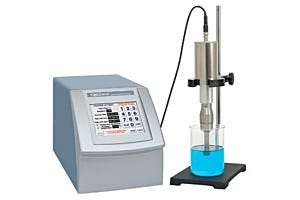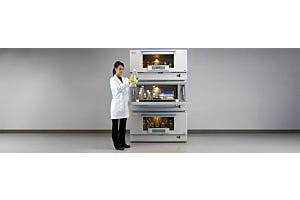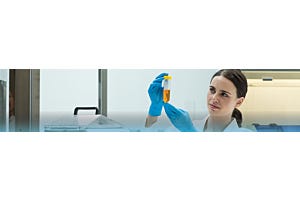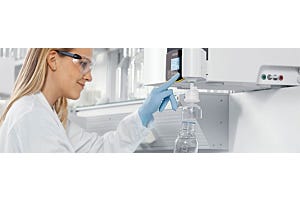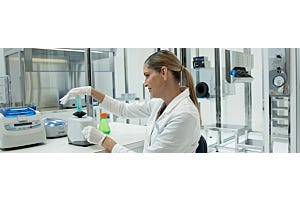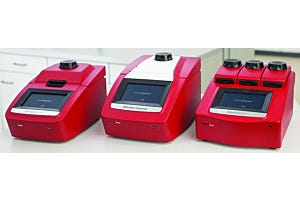
What is a Laboratory Dry Bath?
Dry baths contain a heating element connected to a removable, machined metal block designed to hold microplates, test tubes, ampules or vials.
Digital Dry Baths
Digital dry baths include a digital controller mounted to the front of the unit that defines temperature and shaking speed parameters and alerts users of completed runs. Dry baths, like water baths, are used for sample thawing, reagent warming, and microbiological assays by clinical labs, academic research facilities, and drug development companies.
Dry Bath Blocks, Tubes, and Vials
Each metal block is manufactured to store a specific tube style or size, from 1.5 ml flip-cap tubes to 96-well microplates. The metal blocks are removable and may be quickly swapped to accommodate protocols calling for different tubes or vials.
Dry baths, or block heaters, offer included or optional covers to protect samples from exposure and prevent heat loss. For samples requiring temporary cold storage, certain dry baths contain cooling coils to maintain temperatures down to -20°C.
What are the Advantages of Laboratory Dry Baths vs Lab Water Baths?
Dry baths offer several advantages over water baths or immersion circulators. As dry baths don’t contain water or bath fluid, they are better suited to protect samples against cross-contamination. Sample blocks can be removed and autoclaved to further disinfect the unit, making dry baths suitable for aseptic research areas. Since the sample blocks are designed to securely hold specific tubes, dry blocks are optimal for heating open containers, such as test tubes or PCR plates. As sample blocks are directly connected to the heating element, dry baths heat to a set temperature in 15 – 30 minutes, while water baths may require 2 hours to reach a set point.
A - Maximum Dry Bath Temperature
(back to chart)
Standard dry baths maintain a temperature range of 5°C above ambient to 100°C.
However, specialized heating blocks, such as Thermo Fisher’s Touchscreen Baths, reach temperatures up to 130°C for substrate melting or enzyme denaturing.
Refrigerated dry baths cool samples down to -20°C for temporary cold storage or warming of low melting point solvents. All Terra dry bath models include over-temperature controls and audible alarms to alert the user when the temperature exceeds set point.
Shop Dry Baths by Temperature Range
B - Dry Bath Block Positions
(back to chart)
Dry baths contain interchangeable aluminum blocks designed to hold specific vessel styles and sizes, from 10 ml flat-bottom tubes to 50ml conical vials.
For low-throughput research labs, compact dry baths include nesting positions for 1 or 2 removable blocks.
For high-throughput labs processing hundreds of samples concurrently, high-capacity dry baths include positions for up to 4 blocks.
MCertain multi-block models, such as Benchmark’s IsoBlock dry baths, include separate digital controls for each block to support discrete simultaneous assays.
Models like Torrey Pines’ ECHOtherm IC22 utilize sample covers to completely isolate the individual blocks and further protect samples from cross-contamination
Compare Dry Baths by Block Type
C - Dry Bath Maximum Shaking Speed
(back to chart)
The Torrey Pines’ ECHOtherm SC25 provides orbital mixing up to 1,000 rpm for sample mixing, cell suspension or dissolution testing.
Shaking dry baths include magnets installed on the corners of the unit to hold the aluminum blocks in place during high-speed mixing.
D - Dry Bath Voltage
(back to chart)
120-volt connections are suitable for standard laboratory power outlets in the United States.
240-volt connections, common in Mainland Europe, require less current (amperage) and smaller conductors than equipment designed to operate at 120-volt.
E - Special Dry Bath Applications and Features
(back to chart)
E1 - Refrigerated Dry BathsDry BathRefrigeration
For enzyme deactivation or temporary DNA sample storage, chilling dry baths utilize cooling coils to maintain temperatures down to -20°C. Refrigerated dry baths obviate the need for labs to employ a separate ice bucket for sample chilling.
E2 - Dry Baths with Touchscreen Display
Dry baths with touchscreen interfaces allow saved, password-protected profiles and programmable temperature control protocols.
E3 - Dry Baths Saved Programs
Programmable dry baths include onboard software, with password-protected profiles, to define and quickly recall saved temperature control programs.
E4 - Isolated Dry Bath Blocks
Multi-block dry baths are designed to fully isolate the individual heating blocks for samples prone to cross-contamination.
E5 - Dry Bath Sample Covers
Block lids protect samples from exposure to ambient lab conditions and ensure a high degree of temperature uniformity.
Where Can I Buy Laboratory Dry Baths Online?
Laboratory-Equipment.com is a specialty division of Terra Universal. For nearly 40 years, Terra Universal has served semiconductor, aerospace, life science, pharmaceutical, biotechnology, and medical device markets. Customers appreciate a worldwide network of reps, factory-direct support, and ready-to-ship items available from Terra's manufacturing and warehouse facilities in Fullerton, California.
Shop online to compare pricing, features, and selection for a wide variety of lab dry baths, chillers, heaters, plates and stirrer equipment for applications including general laboratory, PCR, DNA/RNA techniques, ELISA, protein analysis, and cell culture.




